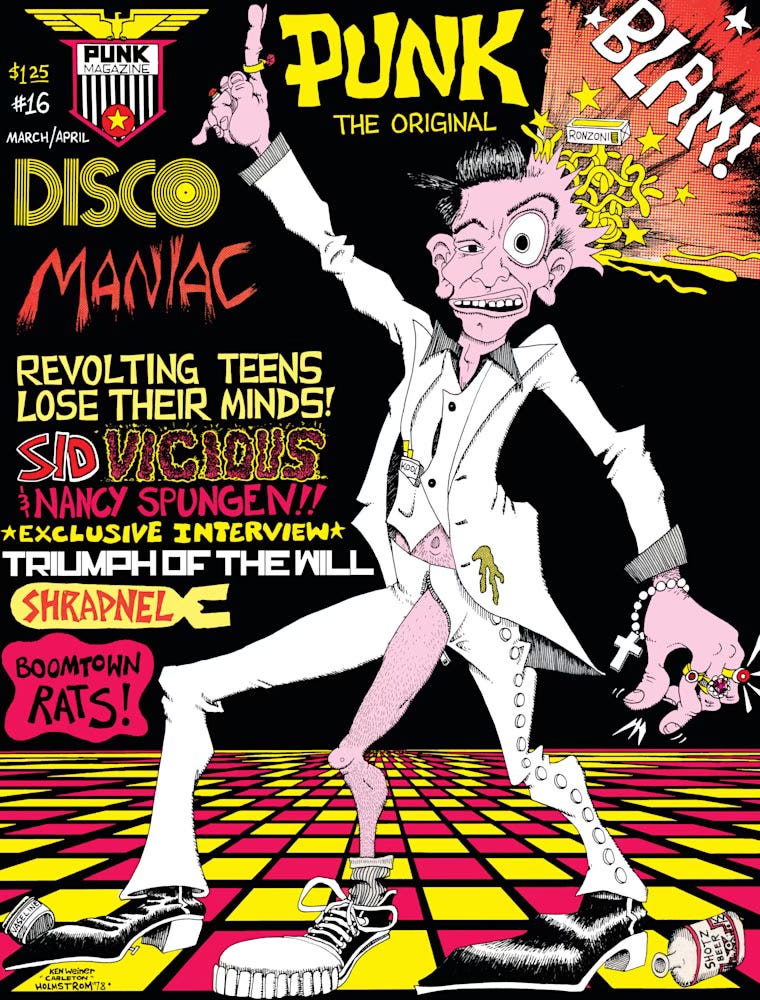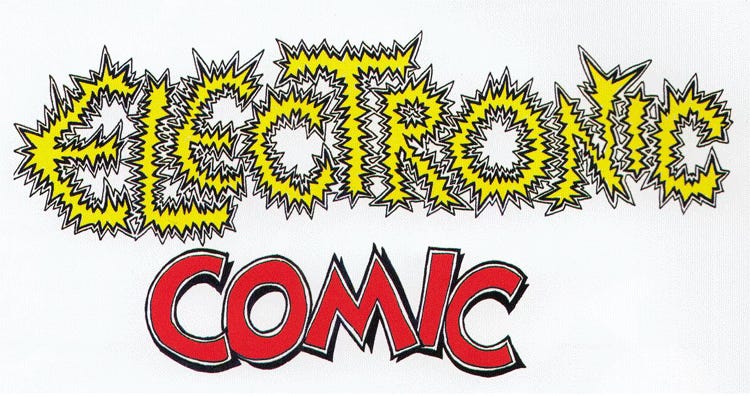It was the day before Christmas Eve, and I still hadn’t figured out what to write for the all-important “Editorial” for PUNK Magazine #1. The rest of the issue had been sent to the printer, so all I had to do is write hand-letter something to fill up the small space on the Contents page. Ged Dunn Jr., the Publisher, was on my ass about it, but I was exhausted.
I knew I had to write something provocative and obnoxious but also relatable and humorous. I didn’t want PUNK to be a pretentious, intellectual vehicle. A magazine about progressive rock or heavy metal (music formats I disliked) would have done that: Run an editorial “mission statement” full of bombast and self-importance and rock stars as The New Gods. (No kidding, metal heads I knew back then had that attitude towards their favorite bands!)
If it was going to be about punk rock? It had to be the opposite.
The first few weeks after Ged Dunn Jr. arrived to launch a film company with Eddie McNeil and a magazine with me in November 1975, there were no discussions about the magazine for a few weeks. Instead we drove Ged’s station wagon between Manhattan and our hometown of Cheshire picking up furniture for our new office on 30th Street and 10th Avenue. Eddie and Ged spent a lot of time focused on the film company, which was understandable. After all, we had joined forces after working on The Unthinkables, Eddie’s short indie comedy film. Besides, neither of them had much experience working in print. So while they plotted and planned Eddie’s movie (a technical film about the mental health facility in Middletown, Connecticut), I put together ideas for a magazine.
My idea for Electronic Comic was to be a mainstream publication, and would have produced a multi-media program with each issue that could be performed in clubs. We could cover the comedy scene, underground theatre and the music scene. After all, Ged and Eddie had promised that we would work together on The Joe Show, the slideshow/ unanimated cartoon Eddie and I worked on a couple of years before. This could have become a successful publication since it had a targeted advertising base (I had a grasp on the business side of things since I read them all the time… until recently. Newsstands have disappeared.) But they had rejected it right away before I could explain the concept.in favor of PUNK—which called for a hardcore approach to a small, emerging music movement.

I looked over the dummy for“Electronic Comic” for ideas and it came to me: “Disco Trash!” Yes! The first PUNK editorial should trash disco! I quickly wrote up my critique, hand-lettered it, then pasted it on the Contents page within a few hours and Ged Dunn, Jr. delivered it to Perez Printing and we were finished. Then I found out why I was so tired: I had the flu! I was sick in bed for a week after writing the editorial in a fever:
I didn’t hate disco music, but it was on the radio a lot back in 1975. “Love to Love You Baby” by Donna Summer was a huge hit that was all over the radio in November (at the same time Bruce Springsteen’s “Born TO Run” was becoming a big hit) That song was so annoying! It was the “In-A-Gadda-Da-Vida” of disco in that both songs heralded a new music format (Iron Butterfly with acid rock/heavy metal, Summer with disco) and both featured extended versions that went on for way too long (both were around 17 minutes). I dare you to sit through either song all the way through:
“In-A-Gadda-Da-Vida”
“Love To Love You Baby”
“Summer’s gasps and groans had journalists nicknaming her ‘the Black Panter’ and ‘the Linda Lovelace of pop.’ Crowning Summer the queen of ‘Sex Rock,’ Time magazine counted no less than 22 simulated orgasms across the record’s almost 17-minute-long span. Neil Bogart, boss of the legendary disco label Casablanca, had asked Moroder to extend the song to a full album because—the story goes—he wished to soundtrack an orgy.”
— Song From The Future: The Story of Donna Summer and Giorgio Moroder’s “I Feel Love,” Pitchfork.
My “Death To Disco Shit” editorial was one of the most popular things in that first issue. It really touched a nerve! One prominent record producer told me that if I made a t-shirt with the editorial on it? It would sell like hotcakes! I thought about it, but didn’t want to go down that road. It was supposed to be a one-off joke, not a serious movement. So I didn’t write any more anti-disco stuff for the mag… Well, maybe just one or two.

By 1978, disco had achieved world domination. The best-selling singles were almost all disco shit, and almost all were produced by the Bee Gees (or worse):
Billboard magazine’s Top-Selling Singles in 1978
"Shadow Dancing" by Andy Gibb (a Bee Gee)
"Night Fever"by the Bee Gees
"You Light Up My Life" by Debby Boone
"Stayin' Alive" by the Bee Gees
LINK to 1978: https://en.wikipedia.org/wiki/Billboard_Year-End_Hot_100_singles_of_1978
LINK to 1979: https://en.wikipedia.org/wiki/Billboard_Year-End_Hot_100_singles_of_1979
1979 wasn’t much better. Punk rock wasn’t selling records—even heavy metal sales were down. Disco became more and more annoying as they used more and more synthesizers. Although they aren’t always credited on the records, synthesizers were being used the way studio musicians played in place of band members: it was kept on the down-low. The use of synthesizers was such a turn-off for record buyers that Queen put: “No Synthesizers!” on their LPs.
According to many historians, disco began its decline after the infamous Disco Demolition Night on July 12, 1979 at Comisky Park in Chicago, but I always doubted this. It’s not as if the yahoos who showed up were disco fans:
LINK: https://www.chicagohistory.org/disco-demolition-night/
Here’s a really great ESPN news story about that night. It’s fuckin’ hilarious!:
I don’t think my “Death to Disco” editorial in PUNK #1 had anything to do with inspiring this event. I think a lot of rock music fans were just pissed off that by 1978-79 disco had taken over radio airwaves. At that point in music history rock bands were “going disco,” beginning with the Rolling Stones’ “Miss You, 1978”), then with Blondie (“Heart of Glass” released in January 1979), Lou Reed (“Disco Mystic”, April 1979), KISS (“I Was Made for Loving You”, May 1979), The Kinks (““(Wish I Could Fly Like) Superman” 1979), and so many others that music critics made up a phony name for it: “Dance-Punk.” But this wasn’t punk rock at all, these were “post-punk,” “new wave” and “no-wave” bands churning out “dance music” by 1980. (I hate the way every kind of 1970s rock music is called “punk rock” nowadays!)
LINK: https://en.wikipedia.org/wiki/Dance-punk
What’s always been weird to me is how “Heart of Glass” transformed the club scene. I think the Blondie song had more to do with the death of disco than anything else: Its phenomenal success created the “New Wave Disco” movement. After the midtown disco club Hurrah’s played new wave and punk rock instead of disco, suddenly a bunch of old and new clubs followed the trend, notably Steve Mass’s Mudd Club.
Unfortunately, as disco music began to die, so did PUNK Magazine.
You can buy an Electronic Comic t-shirt (and a lot more) at wornfree.com:
T-shirts are available in many different colors and sizes.
NEXT WEEK: PUNK #1 goes to press
FINAL NOTE: I have made paid subscriptions available because so many readers indicated that they’d like to support the newsletter directly. I’m now creating “subscription-only” newsletters for people who want more of this kind of content.








